
|
 |
 |
by Peter Tyson July 5, 1998 I'm leaning on a rail high above the fantail of the Tully. A mile away, the Thompson hovers in a nimbus of mist. It's 11:30 a.m., and a number of us have been here since about 8 this morning. The sun is trying to force its way through a damp cloud cover. There's a chill in the air, which my life vest does little to hold at bay. I'd like to fetch my windbreaker, but I can't take my eyes off the thumb-thick yellow line steadily weaving its way through a winch on deck. In the half hour it's been trailing up from the depths, every pair of eyes on the fantail have been glued to it. For if all has gone according to plan, the other end of that line will hold the sulfide chimney known as Phang.
Around 9, the saw suddenly gave out. Had it cut deeply enough that Phang would snap free when the time came? No one had an answer. John Delaney had a tough decision to make. Should he bring ROPOS back to the surface, fix the saw, go back down, and cut some more? Or should he rely on a hunch that chimneys tend to fracture along certain lines anyway and go for it as is? The former would take too much time, he decided, and the risk of the latter was worth it. No stranger to taking chances, Delaney had ROPOS go on to the next step in the procedure: attaching the yellow line that snaked away to the line basket. It was the very basket that Le Olson had his wife help him set up and that we lowered off the Thompson yesterday. Phang was now ready for removal.
It's now approaching noon, and the chill has finally gotten to me. I race down the metal steps to the Tully's main lab, throw on my windbreaker, and race back up to my spot two stories up. Reeking of diesel, the air shakes with the lawnmower-from-hell sound of the winch engine. (An earnest man named Duke, who seems more cowboy than first mate, handed around earplugs earlier.) Every now and then, hot exhaust from the winch shoves the cold breeze aside. Below me, the yellow line has just turned into a blue line, a signal that we're halfway. Even though it will take a good hour to reel in all 8,000 feet of line, everyone stares at the water just off the stern. Everyone's waited too long for this.
I was up till one last night finishing up my last dispatch. Ten minutes after I lay my head down (or so it seemed), my alarm went off: 6:30 a.m., time to go to the Tully. The NOVA film crew and I rode over on the zodiac; this time I was ready with raingear. Then we began the long wait while the release on the line basket 7,000-plus feet below was acoustically triggered and the front end of the yellow/blue line floated to the surface. Delivered to the Tully by the zodiac a bit over an hour ago, it was tied onto the winch line, and then a new wait began. It's now ending. From the very back corner of the ship, where Olson and Duke the cowboy have kindly allowed me to stand, I suddenly see a flash of color in the silver-blue envelope of the sea. It's the orange glass floats attached to the top of the frame that ROPOS placed last night over Phang. Then it's out, Phang, hanging in the air below the A-frame like a treasure chest. Which, if you ask the scientists now gaping at it dripping on the deck, it most assuredly is.
Viewing the seafloor through ROPOS' cameras is as thrilling as watching the rover on Mars. But this is like being there. Peter Tyson is Online Producer of NOVA. The Tug of the Thompson (June 23) The ROPOS Guys (June 25) In the Juan de Fuca Strait (June 27) Special Report: A Visit To Atlantis (June 29) Dive 440 (July 1) Rescue at Sea (July 2) What's Your Position? (July 4) Phang! (July 5) 20,000 Pounds of Tension (July 8) Four for Four (July 11) Thrown Overboard (July 13) Was Grandma a Hyperthermophile? (July 15) Swing of the Yo-Yo (July 18) The Mission | Life in the Abyss | The Last Frontier | Dispatches E-mail | Resources | Table of Contents | Abyss Home Editor's Picks | Previous Sites | Join Us/E-mail | TV/Web Schedule About NOVA | Teachers | Site Map | Shop | Jobs | Search | To print PBS Online | NOVA Online | WGBH © | Updated October 2000 |
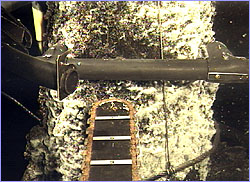 The chainsaw prepares to slice into Phang.
The chainsaw prepares to slice into Phang.
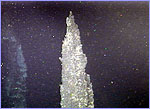 Phang on the seafloor.
Phang on the seafloor.
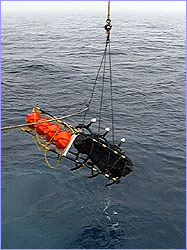 Phang sees the light of day for the first time.
Phang sees the light of day for the first time.
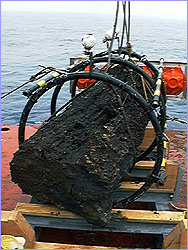 Phang on deck.
Phang on deck.
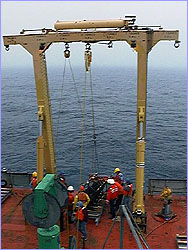 Seamen and scientists alike gather around the
chimney.
Seamen and scientists alike gather around the
chimney.